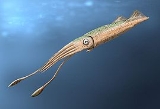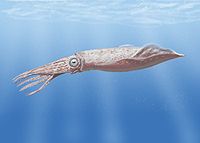
Tusoteuthis
Encyclopedia
Tusoteuthis is a genus of Cretaceous
cephalopod
molluscs. One species, T. longa, has been identified so far, and examination of gladius remains has yielded an estimated mantle
length close to or equal to that of the modern giant squid
. Recent studies have seen the vampire squid
as a more likely descendant than modern day giant squid. Tusoteuthis is assumed to have preyed on other cephalopods, fish, and possibly even small marine reptiles.
 Despite Tusoteuthis size, which was around 20 to 35 feet (6 to 11 meters) long with tentacles fully outstretched, it was still preyed on by other animals, especially the many, various predatory fish of the Western Interior Seaway
Despite Tusoteuthis size, which was around 20 to 35 feet (6 to 11 meters) long with tentacles fully outstretched, it was still preyed on by other animals, especially the many, various predatory fish of the Western Interior Seaway
. A fossil of the predatory salmonid, Cimolichthys
nepaholica, was found with the gladius of T. longa in its gullet. The back portion of the gladius was in the stomach region, while the mouth of C. nepaholica had remained opened, suggesting that the fish had died in the middle of swallowing the squid, tail first. Researchers strongly suspect that as the fish was swallowing Tusoteuthis, the head and or tentacles remained outside the mouth, thus blocking the gills of the fish, and suffocating it as it swallowed its prey.
Cretaceous
The Cretaceous , derived from the Latin "creta" , usually abbreviated K for its German translation Kreide , is a geologic period and system from circa to million years ago. In the geologic timescale, the Cretaceous follows the Jurassic period and is followed by the Paleogene period of the...
cephalopod
Cephalopod
A cephalopod is any member of the molluscan class Cephalopoda . These exclusively marine animals are characterized by bilateral body symmetry, a prominent head, and a set of arms or tentacles modified from the primitive molluscan foot...
molluscs. One species, T. longa, has been identified so far, and examination of gladius remains has yielded an estimated mantle
Mantle (mollusc)
The mantle is a significant part of the anatomy of molluscs: it is the dorsal body wall which covers the visceral mass and usually protrudes in the form of flaps well beyond the visceral mass itself.In many, but by no means all, species of molluscs, the epidermis of the mantle secretes...
length close to or equal to that of the modern giant squid
Giant squid
The giant squid is a deep-ocean dwelling squid in the family Architeuthidae, represented by as many as eight species...
. Recent studies have seen the vampire squid
Vampire Squid
The vampire squid is a small, deep-sea cephalopod found throughout the temperate and tropical oceans of the world. Unique retractile sensory filaments justify the Vampire Squid's placement in its own order: Vampyromorphida , which shares similarities with both squid and octopuses...
as a more likely descendant than modern day giant squid. Tusoteuthis is assumed to have preyed on other cephalopods, fish, and possibly even small marine reptiles.

Western Interior Seaway
The Western Interior Seaway, also called the Cretaceous Seaway, the Niobraran Sea, and the North American Inland Sea, was a huge inland sea that split the continent of North America into two halves, Laramidia and Appalachia, during most of the mid- and late-Cretaceous Period...
. A fossil of the predatory salmonid, Cimolichthys
Cimolichthys
Cimolichthys is an extinct genus of predatory salmonid fish from the Late Cretaceous of North America and Europe....
nepaholica, was found with the gladius of T. longa in its gullet. The back portion of the gladius was in the stomach region, while the mouth of C. nepaholica had remained opened, suggesting that the fish had died in the middle of swallowing the squid, tail first. Researchers strongly suspect that as the fish was swallowing Tusoteuthis, the head and or tentacles remained outside the mouth, thus blocking the gills of the fish, and suffocating it as it swallowed its prey.
External links
- Cretaceous Giant Squid at TONMO.com
- http://www.oceansofkansas.com/FossilFish/Cimolichthys/squidcim.jpg Image of CimolichthysCimolichthysCimolichthys is an extinct genus of predatory salmonid fish from the Late Cretaceous of North America and Europe....
fossil with swallowed T. longa gladius - nationalgeographic-tusoteuthis

